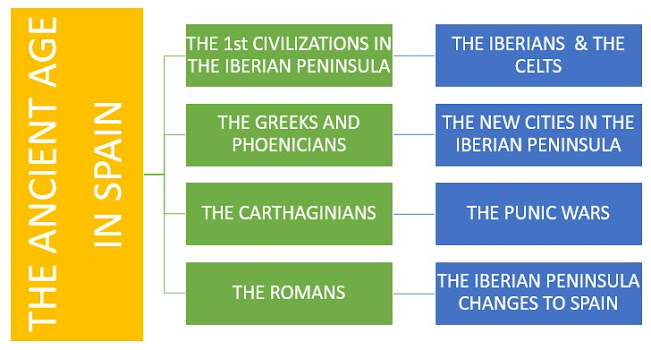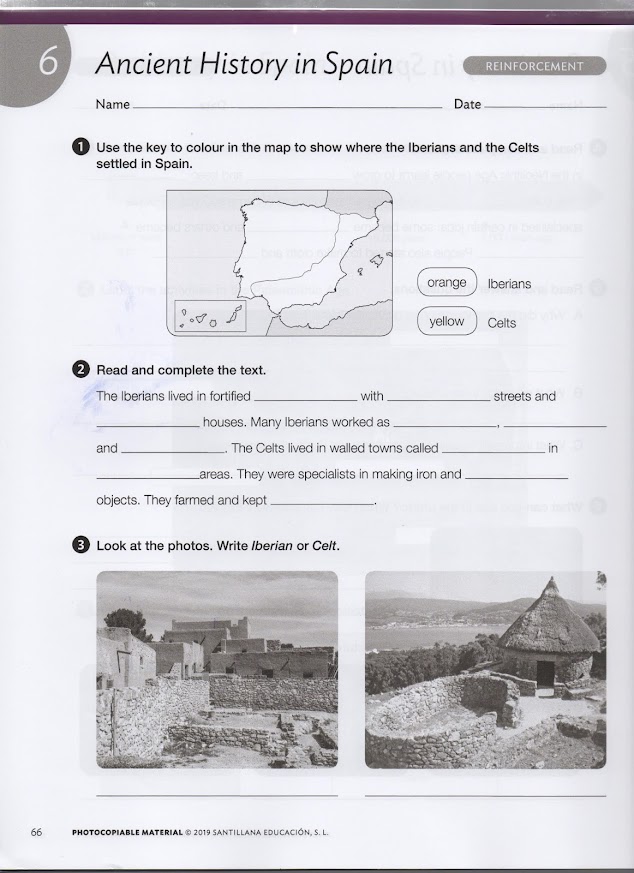UNIT 6:
THE ANCIENT AGE IN SPAIN
ACROPOLIS AGORA
AMPHITHEATRE AQUEDUCT
BATH BUST
CIRCUS CIVILIZATION
COLONY EMPIRE
FORUM LATIN
LEGIONNAIRE POLIS
REMAIN SACK
SCRIPT SIEGE
TEMPLE THEATRE
Read the pages 88/89 and complete these sentences.
1. The first two civilizations in the Iberian Peninsula were ……………………… and ………………..…..
2. Many Iberians were………………….and…………………….and some other were …………………..
3. The Iberian had their own ……………………………. and ……………………… They live in big …………………………………… with stone streets and ………………………..houses.
4. The Celts were………………….…….. and……………………………. They used to work with metals such as …………….………. and ……………………….
5. The …………………………….. develop the first version of the ……………………………. that we use today.
Read the pages 90/91 and complete these sentences.
1. Trading increase in the Iberian Peninsula thanks to the colonies that ………………………and ………………………… founded.
2. The most important Greek cities in the Iberian Peninsula were ………………. and……………………. The colonies had an……………………. with temple and an ………………….. with a market.
3. The most important Greek cities in the Balkan Peninsula were ………………. and…………………….
4. The Phoenicians conquered the ………………………….. Iberian Peninsula about ………………. years ago. They founded cities such as ………………………, ………………………… and ………………………..
Read the pages 92/93 and complete these sentences.
1. The …………………………….came from ……………….. in north Africa. They were ………………. and …………………… They conquered the Iberian Peninsula about ………………… years ago and founded cities such as ………………….. and ………………………
2. The Iberian Peninsula had …………………………… such as gold, silver and ………………………… The …………………….. also wanted to settle on the Iberian Peninsula and they had to fight against …………………………
3. Romans was a city-state that develop a powerful ………………… with soldiers called ………………………….The Romans invaded the Iberian Peninsula in …………………….. and they called it …………………
Read
the pages 94/95 and complete these sentences.
1. 1. The Romans had to fight against the ………………………… to
conquer the Iberian Peninsula. Finally, in ………………, the Emperor ……………………. defeated
the Celts.
2. 2. The Romans divided Hispania into five ……………………… which were: …………………………….,
……………………………, ……………………………, ………………………….. and ……………………………….
HERE YOU HAVE SOME INTERACTIVE ACTIVITIES TO REVIEW THE THEORRY OF THE UNIT.... THEY ARE FROM LIVEWORKSHEETS, SO AT THE END, REMEMBER TO SEND ME THE RESULTS TO MY EMAIL.











